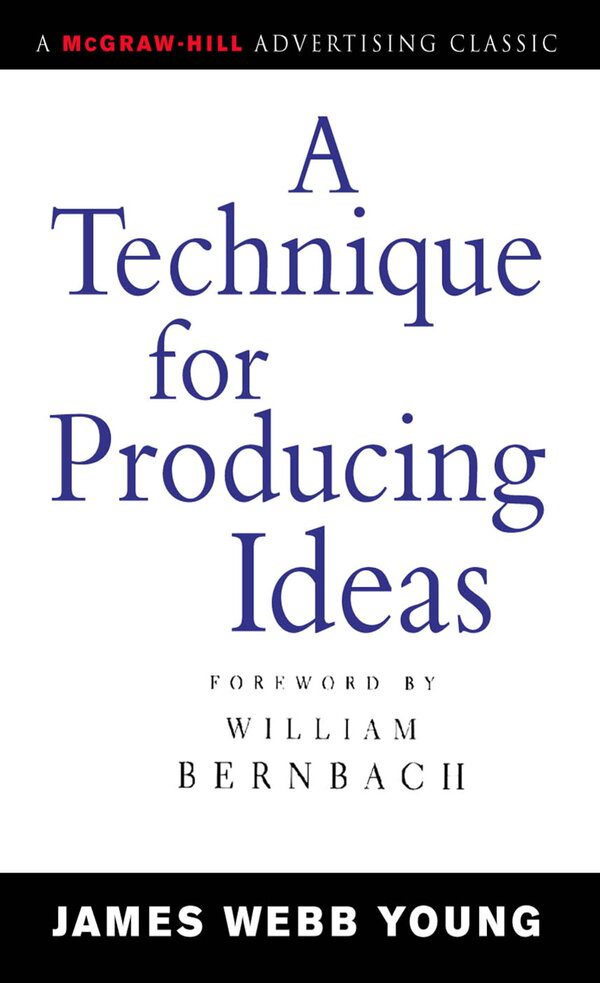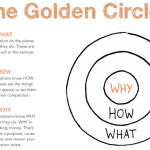First published in 1965, A Technique for Producing Ideas is a classic book used by advertising copywriters, poets and writers to generate great ideas. Young’s thought on the technique for producing great ideas was first presented to graduate students in advertising at the School of Business of the University of Chicago and later before several gatherings of active advertising practitioners.
In A Technique for Producing Ideas, American advertising executive and first chairman of The Advertising Council, James Webb Young highlights a five-step process for generating great ideas.
- First, the gathering of raw materials—both the materials of your immediate problem and the materials which come from a constant enrichment of your store of general knowledge.
- Second, the working over of these materials in your mind.
- Third, the incubating stage, where you let something beside the conscious mind do the work of synthesis.
- Fourth, the actual birth of the Idea—the “Eureka! I have it!” stage.
- And fifth, the final shaping and development of the idea to practical usefulness.
Ideas
They appear just as suddenly above the surface of the mind—and with that same air of magic and accountability. The production of ideas is just as definite a process as the production of Fords; that the production of ideas, too, runs on an assembly line; that in this production the mind follows an operative technique which can be learned and controlled; and that its effective use is just as much a matter of practice in the technique as is the effective use of any tool.
The Pareto Theory: Speculator vs Rentier
Pareto thought that all the world could be divided into two main types of people. These types he called, in the French in which he wrote, the speculator and the rentier.
Speculators (Reconstructors)
The speculator is the speculative type of person. And the distinguishing characteristic of this type, according to Pareto, is that he is constantly preoccupied with the possibilities of new combinations.
Speculators: He is constantly preoccupied with the possibilities of new combinations
Rentier (Stockholder)
The term used by Pareto to describe the other type, the rentier, is translated into English as the stockholder—though he sounds more like the bag holder to me. Such people, he says, are the routine, steady-going, unimaginative, conserving people, whom the speculator manipulates.
Rentiers are the routine, steady-going, unimaginative, conserving people, whom the speculator manipulates.
Training the Mind
In learning any art the important things to learn are, first, Principles, and second, Method. This is true of the art of producing ideas. With the art of producing ideas. What is most valuable to know is not where to look for a particular idea, but how to train the mind in the method by which all ideas are produced and how to grasp the principles which are at the source of all ideas.
Consequently, the habit of mind which leads to a search for relationships between facts becomes of the highest importance in the production of ideas. Now, this habit of mind can undoubtedly be cultivated.
Rapidly Aging Facts
Particular bits of knowledge are nothing because they are made up of what Dr. Robert Hutchins once called rapidly aging facts. Principles and method are everything.
Ideas Are New Combinations
In the production of ideas, the mind follows a method which is just as definite as the method by which, say, Fords are produced.
The Five Steps for Generating Ideas
- Gathering raw material
The first of these steps is for the mind to gather its raw material.
Material Gathering vs Wool Gathering
Gathering raw material in a real way is not as simple as it sounds. It is such a terrible chore that we are constantly trying to dodge it. The time that ought to be spent in material gathering is spent in wool gathering. Instead of working systematically at the job of gathering raw material we sit around hoping for inspiration to strike us.
When we do that we are trying to get the mind to take the fourth step in the idea-producing process while we dodge the preceding steps. The materials which must be gathered are of two kinds: they are specific and they are general. In advertising, the specific materials are those relating to the product and the people to whom you propose to sell it.
The Power of Curiosity
Every really good creative person in advertising whom I have ever known has always had two noticeable characteristics. First, there was no subject under the sun in which he could not easily get interested—from, say, Egyptian burial customs to modern art. Every facet of life had a fascination for him. Second, he was an extensive browser in all sorts of fields of information. For it is with the advertising man as with the cow: no browsing, no milk.
Young had two practical suggestions on the process of gathering material:
- This is simply to get yourself a supply of those little 3 × 5 ruled white cards and use them to write down the items of specific information as you gather them.
- The second suggestion is that for storing up certain kinds of general material some method of doing it like a scrapbook or file is useful.
2. The Mental Digestive Process
It is the process of masticating the gathered materials, as you would food that you are preparing for digestion.
This part of the process is harder to describe in concrete terms because it goes on entirely inside your head. What you do is to take the different bits of material which you have gathered and feel them all over, as it were, with the tentacles of the mind. You take one fact, turn it this way and that, look at it in different lights, and feel for the meaning of it.
You bring two facts together and see how they fit. What you are seeking now is the relationship, a synthesis where everything will come together in a neat combination, like a jig-saw puzzle.
As you go through this part of the process two things will happen.
- First, little tentative or partial ideas will come to you. Put these down on paper. Never mind how crazy or incomplete they seem: get them down. These are foreshadowings of the real idea that is to come, and expressing these in words forwards the process.
- The second thing that will happen is that, by and by, you will get very tired of trying to fit your puzzle together. Let me beg of you not to get tired too soon. The mind, too, has a second wind. Go after at least this second layer of mental energy in this process. Keep trying to get one or more partial thoughts onto your little cards.
3. Write everything down
In this third stage, you make absolutely no effort of a direct nature. You drop the whole subject and put the problem out of your mind as completely as you can. What you have to do at this time, apparently, is to turn the problem over to your unconscious mind and let it work while you sleep.
In the first stage you have gathered your food. In the second you have masticated it well. Now the digestive process is on. Let it alone— but stimulate the flow of gastric juices.
4. Constantly Thinking About It
Now, if you have really done your part in these three stages of the process you will almost surely experience the fourth. Out of nowhere, the Idea will appear. It will come to you when you are least expecting it—while shaving, or bathing, or most often when you are half awake in the morning. It may waken you in the middle of the night.
This is the way ideas come: after you have stopped straining for them and have passed through a period of rest and relaxation from the search.
5. The Final Stage
The stage which might be called the cold, gray dawn of the morning after. In this stage you have to take your little newborn idea out into the world of reality. And when you do you usually find that it is not quite the marvelous child it seemed when you first gave birth to it. It requires a deal of patient working over to make most ideas fit the exact conditions, or the practical exigencies, under which they must work.
And here is where many good ideas are lost. The idea man, like the inventor, is often not patient enough or practical enough to go through with this adapting part of the process. But it has to be done if you are to put ideas to work in a work-a-day world.
Share your Ideas
Do not make the mistake of holding your idea close to your chest at this stage. Submit it to the criticism of the judicious. When you do, a surprising thing will happen. You will find that a good idea has, as it were, self-expanding qualities. It stimulates those who see it to add to it. Thus possibilities in it which you have overlooked will come to light.
All the Best in your quest to get Better. Don’t Settle: Live with Passion.



Comments are closed.